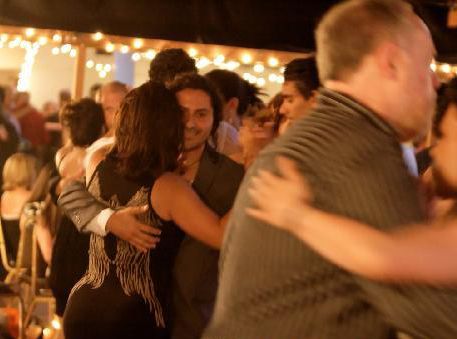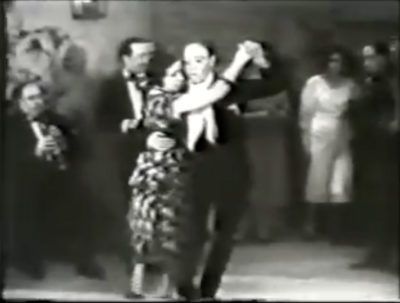On learning to dance Argentine Tango
By Álvaro Dominguez.
Several years ago, drawn by my love for and interest in Tango music, I began pursuing learning how to dance Tango.
Little did I know about the experiences this new practice would bring me or the paths it would take me through.
Like most incipient Tango dancers of the twenty first century, I thought dancing was a sequence of steps requiring a great level of mastery.
Consequently, I sought popular instructors that gave the impression of doing graceful moves across the floor on their dance studios.
These wonderful instructors showed me do a bunch of steps; the ocho, the cross, the rock-step, the boleo, the molinete… all off course with Tango music in the background.
Although I had the steps under my belt I did not feel I was dancing…something was missing and I had no clue of what that was.
Pursuing the feel of dancing I began going to all the Milongas I found within a 20 miles radius.
In doing so I soon noticed that none of the popular teachers were at the Milongas.
At the time I did not think much of it, I was a novice after all, but time it made me wonder.
Over a year after I began my Tango adventure a friend invited me to join her to a class.
I had heard of the teacher but I had not met him.
The class was small and the exercises were different. No steps. The emphasis was exclusively on musicality and connection.
Following the lead of our instructor we moved, weighing the beat of the music and keeping engaged with our dance partner.
Such approach was radical compared to previous Tango instruction I had received, and I confess that initially, the relevance and importance of being fully engaged when playing the game of dancing Tango passed way over my head…but eventually I came around as I began to realize and accept that the right attitude is essential for truly dancing Tango.
A person’s attitude towards Tango is reflected in many aspects of his or her behaviors: our posture, how assertively and in synchrony with the music we move (or not), how we emphasizing the beat with our steps (or not), and even how we choose to dress when going out to the Milonga depict and reflect our attitude towards Tango and our dance partners.
Tango is an experience, it’s an experience of engagement with the music and with our dance partner; and once I began to realize this I began to experience Tango for what it is, when you dance Tango you experience connection.
It’s been funny to realize that I’ve learned as much Tango by talking with seasoned Milongueros about the dance, the music, and the curious or funny anecdotes of singers, players, or orchestra directors as I’ve learned from dance instructors.
During these conversations I learned and began to accept that, first and foremost, Tango dancing is an act of self-expression; I learnt that Tango lives and develops at the Milonga; and I learnt that for many, dancing Tango is sacred.
The Embrace
Repeatedly I’ve heard that the embrace is the most important aspect of Tango dancing.
Being in close physical proximity to another person brings to surface many emotions; that may explain why many dancers don’t pay attention to their embrace, as if tightly holding a body you chose to embrace was a chore and not a pleasure.
Tango is connection, connection with ourselves (we must be fully present to dance), connection with our partner, and connection with the music; the embrace is where followers rest and how leaders provide assurance and guidance, and the music is the excuse for dancers to keep embraced; intermittently for about three minutes at a time; moving through the dance floor, or barely not.
A good embrace holds many paradoxes; it is firm and flexible, it gives structure and freedom of movement; a good embrace allows two to become one, only if each part is accountable for its own. When dancing closely embraced I juggle many emotions; I want to allow and fully enjoy the sensations that arise embracing my dance partner, and at the same time I want to provide her with comfort and assurance while she is in my arms.
The Tango embrace represents the juice of human relations, we offer ourselves to our dance partner and to the dance floor, and whether we like it or not, part of our emotional being comes out naked.
Thus, if we believe this and the embrace brings to surface so many emotions; how do we choose who to dance with?
Seasoned milongueros and milongueras agree that when they are not engaged dancing or socializing at the Milonga they pay attention to the dancers on the floor: who is moving gracefully? Who is musical? Who is having a good time? Is their dance partner having a good time?
All this information is processed consciously and unconsciously, and the result is our decision of who we want to dance with…or not.
The Milonga and its Codes
The Milonga is a social event where people gather to dance Tango.
The Milonga provides more than the physical structure, such as the quality of the dance floor, the way tables and chairs are arranged around the dance floor, or the music played by the DJ. Like Tango, the Milonga is about attitude, and a good Milonga fosters an attitude that promotes safe dancing rendezvous.
This attitude is determined by big and minuscule details; from how you are greeted by the host to the venue’s seating arrangements; from the lighting of the space to the way the patrons dance, their social skills, and the way they cared for themselves for the occasion.
On top of all that, another essential aspect of a Milonga is the adherence to the codes of the Milonga.
The codes of the Milonga are simple – music is organized in Tandas of three or four songs by the same orchestra, tandas are separated by cortinas (a non sequitur song), and dancers dance in the line of dance, counter clock wise.
Another important code is ‘cabeceo’. Cabeceo, or head nod, is the way you indicate another person you are interested in dancing with them. Unfortunately, this etiquette protocol is often overlooked locally; in fact, many local dancers (San Francisco Bay Area) resist this cultural aspect of the Milonga, and refuse to accept that cabeceo is essential because it promotes better dancing.
How does cabeceo promote better dancing? You may ask; the answer is simple.
Cabeceo:
Establishing eye contact with a potential dance partner and nodding your head indicates you are asking that person to dance.
If the person being nodded wants to decline the invitation, he or she discretely stops or avoids establishing eye contact; instead if the person wants to accept the invitation, he or she maintains eye contact and gives head nod in-turn to confirm.
Once the willingness to dance has been established, the leader walks towards the follower, looking for her sight and maintaining eye contact when possible.
The follower remains on her seat, once the leader has approached and has nodded again she gets up and proceeds to accept the dance.
Let’s say you are a seasoned Tango dancer at a Milonga.
A new Tanda starts with one of your favorite songs, “Te aconsejo que me olvides” played by Troilo and sang by Fiorentino.
You know this song by heart, and you start feeling the melody slowly creeping inside your body and you start looking for the right dance partner.
Who is the right dance partner?
Is it the first available follower at sight? Is it the first leader that nods you?
Well, maybe.
Sometimes those are our best options and we take them; however, more seasoned dancers usually don’t.
The Milonga is a social event, not a practice, and in general we want to dance with partners of our own dancing level, a partner that we are confident will understand how we move and respond accordingly.
When there is a big gap between dance partners’ abilities, it is likely that one is enjoying it more than the other, and this gap means that degree of self-expression is distorted.
Although we learn much by dancing with a more experienced dancer, the Milonga is not a practice.
Going back to you, seasoned dancer, at the Milonga where “Te aconsejo que me olvides” just opened the Tanda; you look around and see followers and leaders scaning the room for potential dance partners.
So, who do you want to dance this Tanda with…maybe someone with whom you’ve already enjoyed dancing Troilo with, maybe a leader with a melting embrace, maybe a soft and sensitive follower that is like a cloud flowing with the slightest breeze.
The beauty of cabeceo is that it clearly sets the difference between a practica and a Milonga; it allows dancers to respectfully decline an invitation, or to accept without uttering a word.








